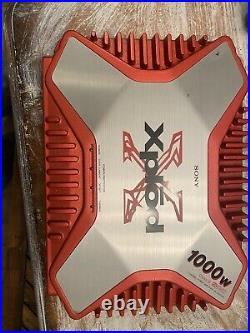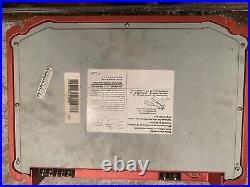Xm-3001sxd


Used but in great condition and works perfectly! Class D Technology: Class D amplifier design is used to maximize efficiency, while maintaining the ability to drive difficult loads. The class D design allows this unit deliver a lot of power without generating as much heat as other amplifier designs, and it can drive a 1-ohm load. Crossover: This amplifier includes a continuously variable 12dB/octave, 50-300 Hz low-pass crossover. Since this amplifier is made specifically for driving subwoofers, the crossover is always active; it is not possible to obtain full range output from this amplifier. Bass Boost: Bass response may be boosted from 0 to +10dB for frequencies around 40 Hz. Test-tone: The amplifier includes a built-in oscillator that can be activated to check system performance; if the test-tone button is pressed and tones are heard through your speakers, the amplifier is in good working condition. Over current: shuts off the amp when the input signal is too high. Offset: shuts off the amp when the output voltage is too high. Thermal: shuts off the amp when the operating temperature is too high. Line-out: One set of RCA stereo jacks are provided for easy connection to a second amp; the output signal is a full-range pass through signal from the inputs. Supply voltage for power ratings: 14.4V DC. RMS power at 4 ohms: 300 watts x 1 (20-300Hz, at 0.2% THD). RMS power at 2 ohms: 600 watts x 1 (20-300Hz, at 0.6% THD). RMS power at 1 ohms: 1000 watts x 1 (20-300Hz, at 1.2% THD). Max power output at 4 ohms: 600 watts x 1. Max power output at 2 ohms: 1200 watts x 1. Operating voltage: 10.5-16V allowable. Current consumption (at rated output): 40 A. Crossover frequency control: an inset rotary control that sets the crossover cut off frequency from 50 to 300Hz. Low Boost control: an inset rotary control used to set the bass boost from 0 to +10dB at 40 Hz. Level control: an inset rotary control used to set the amplifier’s input sensitivity to match the level of the incoming signal. Test Tone button: allows for system condition check; if tones are heard when the button is pressed, the system is in good condition. Over Current LED: illuminates in red when receiving a powerful signal. Offset LED: illuminates in red when the voltage going out to the speaker terminal or the pin jack is too high. Thermal LED: illuminates in red when the temperature rises to an unsafe level. Power LED: illuminates green when the unit is on. +12V (power): screw terminal (0.555 wide). GND (ground): screw terminal (0.555 wide). REM (remote turn-on): push-pin spring terminal (accepts 16- to 22-gauge wire). Speaker-level inputs: push-pin spring terminals (accept 16- to 22-gauge wire). Line-In: two RCA jacks. Line-Out: two RCA jacks. Fuse: three 25 amp fuses (inserted). Speaker outputs: screw terminals (0.35 wide). Note: There are two +/- pairs of speaker terminals, but they are connected together internally and they provide mono output. If two 4-ohm speakers are connected, one to each set of terminals, the amplifier will see a 2-ohm load, because the terminals are internally connected, in parallel with each other.


Comments are closed for this entry.